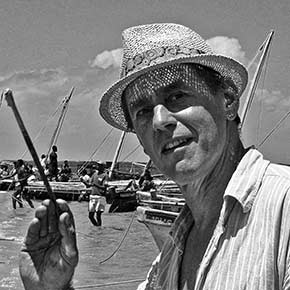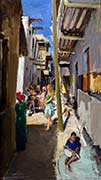Painters 2017
Rob Jacobs
 Crowds of visitors and villagers milled around on Peponi beach under the relentless heat of the midday sun to watch the dhow race. Despite the throbbing music and the mounting excitement of the impending event, Rob Jacobs was part of the main attraction as he squinted at his easel, effortlessly capturing the movement, light and composition of the dhows lined up in front of him. Oblivious to all the attention he was getting, Rob stood knee-deep in watery shallows, a line of paintbrushes stuck in the sand and painted away as though his life depended on it.
Crowds of visitors and villagers milled around on Peponi beach under the relentless heat of the midday sun to watch the dhow race. Despite the throbbing music and the mounting excitement of the impending event, Rob Jacobs was part of the main attraction as he squinted at his easel, effortlessly capturing the movement, light and composition of the dhows lined up in front of him. Oblivious to all the attention he was getting, Rob stood knee-deep in watery shallows, a line of paintbrushes stuck in the sand and painted away as though his life depended on it.
   |
During his three weeks on Lamu Island, Rob’s output was prolific. Dressed in his painting attire of singlet, flowery shorts and jaunty panama, he seemed to be planted around every corner of Shela’s maze of pathways. No subject escaped his notice and as the days passed his canvases grew in size and ambition. As familiar as the muezzin calling the faithful to evening prayer was the sight of Rob returning from another excursion. Struggling back with another freshly painted canvas, he battled through the narrow streets avoiding passing pedestrians, inquisitive donkeys and the pernicious wind.
To say that Rob is an artist who enjoys painting ‘plein air’ is an understatement. He is a dedicated disciple of the movement and is an admirer of the early 19th Century artists. Liberated from their studios by the invention of the paint tube, they embraced the challenges of painting outdoors. When asked what he liked about painting in Lamu, he said that he was “inspired by the simplicity of the light, the love and warmth of the people.” Light is a very important aspect of his art. He appreciates that the very essence of painting outdoors is the task of capturing the light in that fleeting moment. He draws inspiration from Russian painters who he believes are virtuosos in their handling of light.
Trained as an architect, Rob discovered a love of painting in his third year of studies. He was encouraged to pursue his passion by one of his teachers and has combined both ever since. He often mentioned how grateful he was for the opportunity to paint in Lamu. In particular, he relished the impromptu evenings at the ever-growing communal gallery in Baitil Aman, where the figurative artists gathered to inspect the day’s output. He found himself inspired by the diversity of the other artists and enjoyed the crossover of ideas.
More than anything, he was struck by the attitude of the local Shela villagers and how genuine they seemed. “Always cheerful and full of joy, they don’t seem to judge which is something I will miss when I return to the Western world.” His remark embodies the very aim of the 2017 painting festival – to be a “bridge between East and West”

